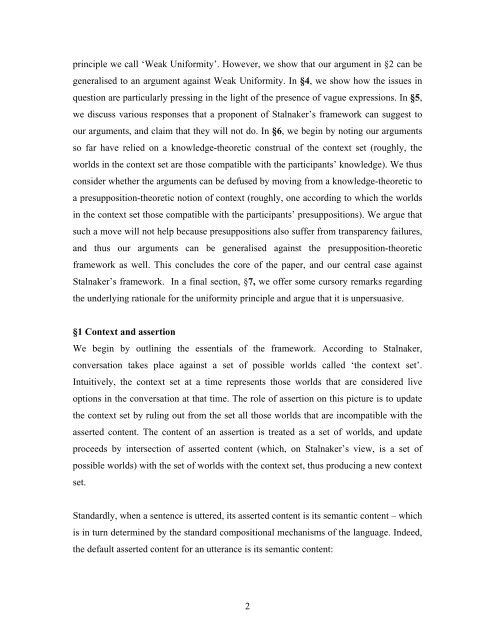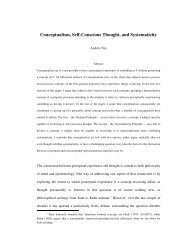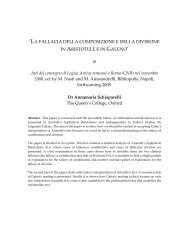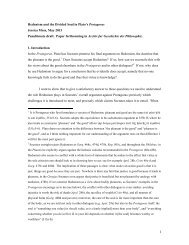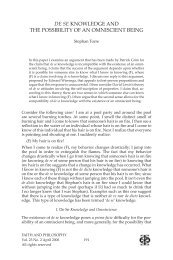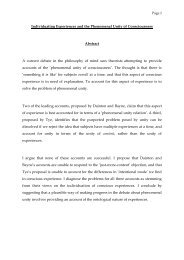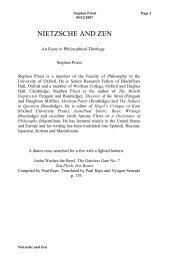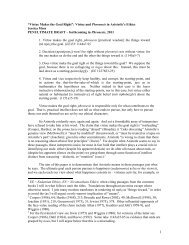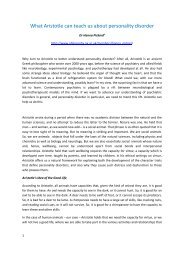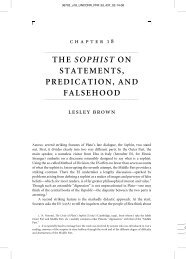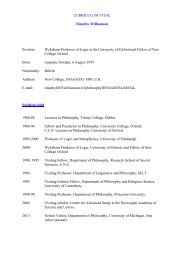In 'Assertion', Robert Stalnaker distinguishes between the sema
In 'Assertion', Robert Stalnaker distinguishes between the sema
In 'Assertion', Robert Stalnaker distinguishes between the sema
You also want an ePaper? Increase the reach of your titles
YUMPU automatically turns print PDFs into web optimized ePapers that Google loves.
principle we call ‘Weak Uniformity’. However, we show that our argument in §2 can be<br />
generalised to an argument against Weak Uniformity. <strong>In</strong> §4, we show how <strong>the</strong> issues in<br />
question are particularly pressing in <strong>the</strong> light of <strong>the</strong> presence of vague expressions. <strong>In</strong> §5,<br />
we discuss various responses that a proponent of <strong>Stalnaker</strong>’s framework can suggest to<br />
our arguments, and claim that <strong>the</strong>y will not do. <strong>In</strong> §6, we begin by noting our arguments<br />
so far have relied on a knowledge-<strong>the</strong>oretic construal of <strong>the</strong> context set (roughly, <strong>the</strong><br />
worlds in <strong>the</strong> context set are those compatible with <strong>the</strong> participants’ knowledge). We thus<br />
consider whe<strong>the</strong>r <strong>the</strong> arguments can be defused by moving from a knowledge-<strong>the</strong>oretic to<br />
a presupposition-<strong>the</strong>oretic notion of context (roughly, one according to which <strong>the</strong> worlds<br />
in <strong>the</strong> context set those compatible with <strong>the</strong> participants’ presuppositions). We argue that<br />
such a move will not help because presuppositions also suffer from transparency failures,<br />
and thus our arguments can be generalised against <strong>the</strong> presupposition-<strong>the</strong>oretic<br />
framework as well. This concludes <strong>the</strong> core of <strong>the</strong> paper, and our central case against<br />
<strong>Stalnaker</strong>’s framework. <strong>In</strong> a final section, §7, we offer some cursory remarks regarding<br />
<strong>the</strong> underlying rationale for <strong>the</strong> uniformity principle and argue that it is unpersuasive.<br />
§1 Context and assertion<br />
We begin by outlining <strong>the</strong> essentials of <strong>the</strong> framework. According to <strong>Stalnaker</strong>,<br />
conversation takes place against a set of possible worlds called ‘<strong>the</strong> context set’.<br />
<strong>In</strong>tuitively, <strong>the</strong> context set at a time represents those worlds that are considered live<br />
options in <strong>the</strong> conversation at that time. The role of assertion on this picture is to update<br />
<strong>the</strong> context set by ruling out from <strong>the</strong> set all those worlds that are incompatible with <strong>the</strong><br />
asserted content. The content of an assertion is treated as a set of worlds, and update<br />
proceeds by intersection of asserted content (which, on <strong>Stalnaker</strong>’s view, is a set of<br />
possible worlds) with <strong>the</strong> set of worlds with <strong>the</strong> context set, thus producing a new context<br />
set.<br />
Standardly, when a sentence is uttered, its asserted content is its <strong>sema</strong>ntic content – which<br />
is in turn determined by <strong>the</strong> standard compositional mechanisms of <strong>the</strong> language. <strong>In</strong>deed,<br />
<strong>the</strong> default asserted content for an utterance is its <strong>sema</strong>ntic content:<br />
2


